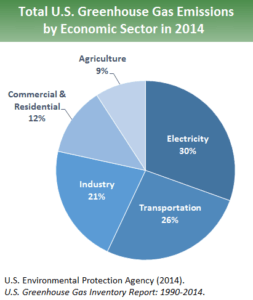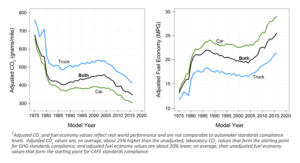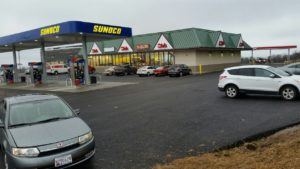The Death of the Gas Station?

The story of BFS Companies is an example of how an entire industry was forced to pivot at the realization of Climate Change.
Climate Change has been at the forefront of scientific discussion for several years now. Particularly the impact humans continue to have through their emissions of greenhouse gases. Being the second largest contributor of carbon dioxide emissions in the United States, transportation is typically heavily scrutinized during most Climate Change discussions. It may come by no shock to learn passenger cars and light-duty trucks are responsible for over half of the emissions from the transportation sector.1
In order to combat this looming trend government regulations, such as the Clean Air Act Amendments of 1990, were passed to provide a road map of more stringent emissions standards for automobile manufacturers.2 These laws have led to a record high average fuel economy of new model vehicles in 2015 with even further improvements expected for 2016. The fuel economy for a 2015 model year car saw a 5.5 mile per gallon, or 28%, increase as compared to a 2004 model year.3
Adjusted CO2 Emissions for MY 1975-20161 Adjusted Fuel Economy for MY 1975-20161
Higher fuel economy is not the only path being taken to reduce transportation effects on Climate Change. Electric cars are becoming more and more prevalent and accessible for the average consumer. In fact, Tesla has announced they will begin production in 2017 of a more affordable “Model 3” electric car starting at $35,000.4
But what does all this mean to the more than 127,000 convenience store petroleum retailers in the United States?5 Do we expect this fragmented industry of small chains and single store owner operators to sit idly by while they watch their industry and livelihood be diminished? The story of BFS Companies is an example of how an entire industry was forced to pivot at the realization of Climate Change.
BFS Companies is a convenience store petroleum retailer headquartered in Morgantown, West Virginia. In the early 1990s a BFS store looked much like any other gas station: a few fuel pumps sitting in front of a building with little square footage and filled to the brim with candy, soda, and cigarettes. But the times were changing, and the industry threats detailed above were beginning to take action. BFS Companies saw the writing on the wall and knew they needed a compelling way to draw customers into the store without relying on petroleum sales.
In 1996 the answer came when the decision was made to combine a convenience store floorplan with a food service restaurant. The idea being that expansion into the food service industry would be a form of diversification from the petroleum industry. Success of the newly formed concept was recognized. In the years since original combination the concept has been replicated and expanded upon. Stores constructed today consist of several food service concepts and a convenience store all under one roof, and all steps away from multiple fuel pumps.
BFS Companies, like many chains, has chosen to develop its concept through partnerships with large fast food franchisors, but some large convenience store petroleum retailers have chosen to develop their own proprietary food concepts. These concepts have also proven to be very successful models of business when properly executed. Nonetheless, the industry, as a whole, has pivoted to a food service focus that just happens to sell petroleum.
From my experience within the convenience store petroleum retail industry, I believe this is just the start to a larger shift within the market. As the regulations and technological advances progress to counteract Climate Change, further diversification within the industry will be necessary. I envision food service will continue to play a larger role for similar companies within the industry. Once electric cars have a critical mass there will also be a transition toward electric fueling stations alongside the petroleum pumps. Furthermore, due to the real estate intensive nature of the business, I believe many companies will further pivot toward real estate development projects and forgo the expansion of their current industries all together.
Word Count: 639
Endnotes:
1 “Sources of Greenhouse Gas Emissions,” United States Environmental Protection Agency website, https://www.epa.gov/ghgemissions/sources-greenhouse-gas-emissions, accessed November 2016.
2 Roy S. Belden, “Clean Air Act,” Basic Practice Series Hein’s ABA Archive Microfiche Collection, Vol. 4, American Bar Association, 2001, p.8.
3 “Light-Duty Automotive Technology, Carbon Dioxide Emissions, and Fuel Economy Trends Report Overview,” United States Environmental Protection Agency website, https://www.epa.gov/fuel-economy/trends-report, accessed November 2016.
4 “Tesla Model 3,” Tesla website, https://www.tesla.com/model3 accessed November 2016.
5 “NACS 2015 Retail Fuels Report,” National Association of Convenience Stores website, https://www.nacsonline.com/YourBusiness/FuelsReport/2015/Documents/2015-NACS-Fuels-Report, accessed November 2016, p. 29.
Image Sources in Order:
1 “Sources of Greenhouse Gas Emissions,” United States Environmental Protection Agency website, https://www.epa.gov/ghgemissions/sources-greenhouse-gas-emissions, accessed November 2016.
3 “Light-Duty Automotive Technology, Carbon Dioxide Emissions, and Fuel Economy Trends Report Overview,” United States Environmental Protection Agency website, https://www.epa.gov/fuel-economy/trends-report, accessed November 2016.
5 Personal photo from Garet Bishop.






Great article Garet. I’d be interested to see the impact of transforming all of those gas pumps into EV charging stations.
Do you think that the modern gas station – as it currently exists – will ever be fully removed? You paint a compelling picture that as the population shifts to EV, more and more other businesses –
*thanks to my PC for publishing before I was ready*
more and more other businesses – quite likely restaurants – will invest in charging infrastructure to ‘refuel’ vehicles. But will petroleum ever go away? Will it continue to be the fuel of choice for long-haul trucking since current battery technology currently isn’t to the point of effectively working for semis?
Garet,
Really interesting post. I hadn’t realized that even in the electric-car-future, people will still have to eat! BFS is really on the ball keeping both cars and their customers fueled up.
In the future, do you think that electric cars will not be charged at gas stations (or the equivalent). With companies like Tesla building out their super charger network, is there an opportunity for BFS to franchise out the gas stations of tomorrow?
-Ole’ JP
Very Interesting article, Garet. Thinking about Gas Stations and their future role, they might shift to something different, but I would dare to say they will still have a place in our day to day lives. Gas Stations have become places of convenience purchases, of car servicing and stops during long road travels. Electric vehicles do not worry me, just the contrary. The fastest charging technology that we have so far is capable of chargin 80% of the battery in 20 minutes. This means an increase in time spent charging the vehicle by 10x. I believe this might increase flow at convenience stores and average ticket.
Hybrid card can be disruptive however. They require less servicing, they last longer and, the most important, they consume way less fuel, requiring less stops at Gas Stations. Toyota Prius for example can drive for 700 miles without stopping on a single tank. This means that a normal commuter would only stop at a Gas Station one time per month, to fill an average size tank.
Fascinating article and case study into diversification of a long-standing business model.
To what extent do you think that the shift into a wider array of products (e.g. convenience products, food-to-go) stemmed from climate change concerns versus simply an opportunity for revenue growth? If their business model depends first and foremost on fuel pump traffic, which BFS can then translate into larger revenue per transaction by offering more products, then their goal might become several fold:
A) Maximize roadside stops at their locations by offering fuel (either in gasoline or possible electric charging in the future)
B) Continue to expand and update assortment of additional products (e.g. food, convenience)
If, however, the data suggests that customers stop for non-fuel reasons (i.e. they are attracted by the food, bathroom, need to buy cigarettes, etc.) they perhaps the strategy could be to:
A) Renovate locations to use space for revenue generating activities (e.g. restaurant or cafe)
B) Ensure sufficient distance from rest areas that could offer same services
Judging from the company’s partnership with fast food locations in addition to convenience stores (http://www.bfscompanies.com/about.php), it might seem that the answer is a combination of both.
Garet, very interesting article and a space that I actually find fascinating but due to the effect that self driving cars will have on this business. You are right that climate change will cause a shift in what gas stations provide as more electric cars hit the road but what happens when self-driving cars hit the road? Will people even ever need to go to gas stations or will cars go on their own when the passenger/owner is at work? If that is the case then what happens to the convenience store or fast food tenants that are bundled with these gas stations? Do gas stations even need to be in convenient locations or do they shift to low cost real estate?
Unfortunately for the gas station owners, I think they have more to worry about than just climate change and may have a more existential threat looming in self driving cars.